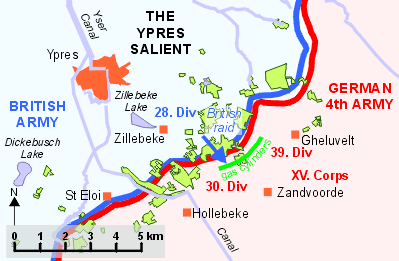 Gas
cylinders discovered at Zillebeke
Gas
cylinders discovered at Zillebeke
28 March 1915
British Raid on German Trenches at Zillebeke

On 28th March there was a British raid on the trenches of the German XV. Corps at Zillebeke, south-east of Ypres. A German officer was captured. In good English he wrote a statement to the effect that gas cylinders had been installed in no-man's-land in front of the German trenches. When the wind was favourable the gas was to be released towards the British trenches.
To verify what the German officer had said the British sent out a patrol into no-man's-land. They found dozens of cylinders just as the German officer had described. The information was passed on to British headquarters. However, the event was not mentioned again until one of the men in the patrol wrote a letter to a British newspaper, the Daily Express, eighteen years later.(1)
The French Fail to Pass on Information about Gas Cylinders
There was, however, a report published on 30 March 1915 about gas cylinders in the Zillebeke battlefield sector in the Bulletin of the French Tenth Army. The French Tenth Army had been holding that sector (from St. Eloi to the Ypres-Menin Road) until the British Army took over this sector in early February 1915. The French were relieved by 27th and 28th Divisions of the British Second Army.
The published report stated that captured Germans told them about iron cylinders, 1.4 metres long, which were stored a little to the rear of the trenches in bomb-proof shelters or were even buried. The gas contained in them was intended to make anyone who came into contact with it unconscious or to asphyxiate him. German pioneer troops had been trained how to use the gas; the cylinder was to be laid on the ground pointing towards the enemy and the cap was taken off. The gas would be forced out by its own pressure. Being a heavy gas it would remain close to the surface of the ground. A favourable wind was absolutely necessary to blow the gas towards the enemy. The pioneer detailed to open the cylinder was to wear a special apparatus on his head to protect him. All the other German soldiers had been provided with a special pad to put over their mouth and nostrils to stop them breathing in the gas.
This information was apparently not passed on to the British troops when they took over the area from the French.(2)
Next>> British troops take over from the French Army
Acknowledgements
(1) Gas! The Battle for Ypres 1915, p. 18 (acknowledgement to Major-General C H Foulkes, Gas! The Story of the Special Brigade, Edinburgh, Blackwood & Sons Ltd., 1934)
(2) British Military Operations: France and Belgium 1915, p. 164 (translation of French Tenth Army Bulletin report)